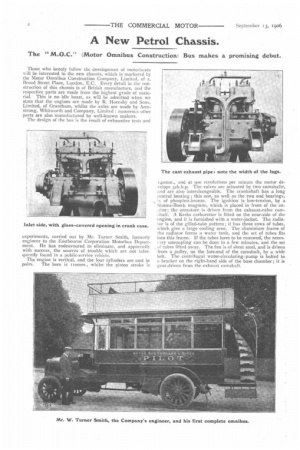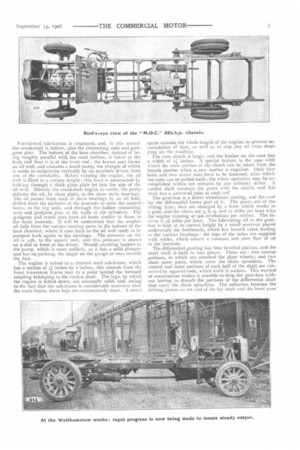A New Petrol Chassis.
Page 2

Page 3

Page 4

If you've noticed an error in this article please click here to report it so we can fix it.
The " M.O.C." (Motor Omnibus Construction] Bus makes a promising debut.
Those who keenly follow the development of motorbuses will be interested in the new chassis, which is marketed by the Motor Omnibus Construction Company, Limited, of 2, Broad Street Place, London, E.C. Every detail in the construction of this chassis is of British manufacture, and the respective parts are made from the highest grade of material. This is no idle boast, as will be admitted when we state that the engines are made by R. Hornsby and Sons, Limited, of Grantham, whilst the axles are made by Armstrong, Whitworth and Company, Limited : numerous other parts are also manufactured by well-known makers. The design of the bus is the result of exhaustive tests and experiments, carried out by Mr. Turner Smith, formerly engineer to the Eastbourne Corporation Motorbus Department. He has endeavoured to eliminate, and apparently with success, the sources of trouble which are not infrequently found in a public-service vehicle.
The engine is vertical, and the four cylinders are cast in pairs. The bore is uromm., whilst the piston stroke is 14onun., and at 900 revolutions per minute the motor develops 32b.h.p. The valves are actuated by two camshafts, and are also interchangeable. The crankshaft has a long central bearing; this one, as well as the two end bearings,
of phosphor-bronze. The ignition is low-tension, by a Simms-Bosch magneto, which is placed in front of the enfine; the armature is driven from the exhaust-valve cam..haft, A Krebs carburetter is fitted on the near-side of the engine, and it is furnished with a water-jacket. The radiator is of the gilled-tube pattern; it has three rows of tubes, which give a large cooling area. The aluminium frame of the radiator forms a water tank, and the set of tubes fits into this frame. If the tubes have to be removed, the neces:.iry uncoupling can be done in a few minutes, and the set of tubes lifted away. The fan is of sheet steel, and is driven from a pulley, on the fore-end of the camshaft, by a wide belt. The centrifugal water-circulating pump is bolted to a bracket on the right-hand side of the base chamber; it is gear-driven from the exhaust camshaft. Forced-feed lubrication is employed, and, in this systemi the crankshaft is hollow, also the connecting rods and gudgeon pins. The bottom of the base chamber, instead of being roughly parallel with the road surface, is lower at. the back end than it is at the front end : the lowest part forms an oil well, and contains a small pump, the plunger of which is made to reciprocate vertically by. an eccentric driven from one of the camshafts. Before running the engine, the oil well is filled to a certain height; this level is ascertained by looking through a thick glass plate let into the side of the oil well. Directly the crankshaft begins to rotate, the pump delivers the oil, by three pipes, to the three main bearings. The oil passes from each of these bearings by an oil lead, drilled from the surfaces of the journals to meet the central bores, to the big ends, and through the hollow connecting rods and gudgeon pins to the walls of the cylinders. The gudgeon and crank pins have oil leads similar to those in the main journals. It will be understood that the surplus oil falls from the various moving parts to the bottom of the base chamber, where it runs back to the oil well ready to be pumped back again to the bearings. The pressure on the oil is 151b. to the square inch, and this pressure is shown ort a dial in front of the driver. Should anything happen to the pump, which is most unlikely, as it has a solid plunger and has no packing, the linger on the gauge at once records the fact.
The engine is bolted to a channel steel sub-frame, which has a section of 311 inches by 2 inches; this extends from the front transverse frame stay to a point behind the forward coupling belonging to the cardan shaft. The lugs, by which the engine is bolted down, are unusually solid, and, owing to the fact that the sub-frame is considerably narrower than the main frame, these ltig.s are conparatively short. A metal apron extends the whole length of the engine, to prevent accumulation of dust, as well as to stop any oil from dropping on the roadway. The cone clutch is large, and the leather on the cone has a width of 2,1 inches. A special feature is the ease with which the cone portion of the clutch can be taken from the female portion when a new leather is required. Only four bolts and two sleeve nuts have to be loosened, after which the cone can be pulled back; the whole operation may be accomplished within ten minutes by any ordinary driver. A cardan shaft connects the gears with the clutch, and this shaft has a universal joint at each end. The gear-box is a heavy aluminium casting, and the case for the differential forms part of it. The gears are of the sliding type; they are changed by a lever which works in a gate, and the ratios are 3, 6, 9, and 12 miles per hour with the engine running at goo revolutions per minute. The reverse is 31 Miles per hour. The lubricating oil in the gearbox is kept at its correct height by a small reservoir piked underneath the footboards, which has branch tubes leading to the various bearings the tops of the tubes are supplied with wicks, which ensure a constant and slow ti OW of oil to the journals. The differential gearing has four bevelled pinions, and the shaft itself is built in four pieces. These are : two central portions, to which are attached the plate wheels; and two short outer parts, which carry the chain sprockets. The central and outer portions of each half of the shaft are connected by squared ends, which work in sockets. This method of construction makes it possible to drop the gear-box without having to disturb the portions of the differential shaft that carry the chain sprockets. The reduction between the driving pinion on the end of the Inv shaft and the bevel gear en the differential is 3i to 1. Final transmission is by
Brampton's heavy roller chains of 11-inch pitch. Radius rods are fitted which are provided at their rearward ends with shock-absorbing cushions.
Three brakes are furnished, and any one of these will pull the vehicle up on an ordinary gradient. The first, worked by a foot pedal, grips two drums, each 14 inches in diameter, on the back wheels; the second, also applied by a pedal, throws the clutch out of action, and, simuliancously, applies the brake on a drum, xi inches in diameter by 4 inches wid-, placed on the differential shaft ; the third is a hand brake, for emergencies only, and this grips the face of a drum, ■-; inches in diameter, on the forward end of the lay shaft.
The frame is built from channel steel, with a section of inches by 2 inches by;"1, inch, and the side members are connected together by six transverse members of the same sec tion. The angles are braced by gussets, and the rivets which hold these are driven in hot. When fully loaded, the top of the chassis is 3z inches from the ground level : the wheel base and track are, respectively, 13 feet 6 inches and 5 feet c inches. Each front spring has eight 2i-inch leaves, whilst the back springs have 12 leaves, each 3 inches wide : the spring slides are cast steel, and they are fitted with Stauffer lubricators placed centrally outside them.
The axles are solid steel forgings of rectangular section ; the front axle is 21 inches by tf: inches, and the back one is 3i inches by 2i inches. Both front and back journals have floating phosphor-bronze bushes.
The chassis, which we describe, is fitted with artillery wheels, shod with Dunlop tires, and forms the first of a batch which has been ordered by the Motor Bus Company, Limited. The vehicle is a good example of present-day motorbus construction, and merits thorough examination.


























